-
 Bitcoin
Bitcoin $114500
-0.31% -
 Ethereum
Ethereum $3648
1.11% -
 XRP
XRP $3.033
-0.27% -
 Tether USDt
Tether USDt $0.9999
-0.01% -
 BNB
BNB $758.5
-0.32% -
 Solana
Solana $167.5
1.48% -
 USDC
USDC $0.9998
-0.02% -
 TRON
TRON $0.3331
0.74% -
 Dogecoin
Dogecoin $0.2039
0.25% -
 Cardano
Cardano $0.7419
-0.46% -
 Hyperliquid
Hyperliquid $39.21
2.66% -
 Stellar
Stellar $0.4049
-1.95% -
 Sui
Sui $3.483
-0.56% -
 Bitcoin Cash
Bitcoin Cash $570.8
2.89% -
 Chainlink
Chainlink $16.67
-0.57% -
 Hedera
Hedera $0.2470
-1.57% -
 Ethena USDe
Ethena USDe $1.001
0.00% -
 Avalanche
Avalanche $22.36
1.52% -
 Litecoin
Litecoin $123.4
4.35% -
 UNUS SED LEO
UNUS SED LEO $8.989
0.09% -
 Toncoin
Toncoin $3.324
-2.40% -
 Shiba Inu
Shiba Inu $0.00001219
-1.30% -
 Uniswap
Uniswap $9.811
2.54% -
 Polkadot
Polkadot $3.662
-0.07% -
 Monero
Monero $295.5
-3.85% -
 Dai
Dai $1.000
0.01% -
 Bitget Token
Bitget Token $4.345
0.24% -
 Cronos
Cronos $0.1380
0.95% -
 Pepe
Pepe $0.00001044
-1.14% -
 Ethena
Ethena $0.5981
-4.24%
What are the differences in mining algorithms for digital currency mining platforms?
Different crypto mining algorithms like PoW, PoS, and DPoS impact hardware needs, energy use, and mining accessibility, influencing platform choice.
Mar 27, 2025 at 03:42 pm
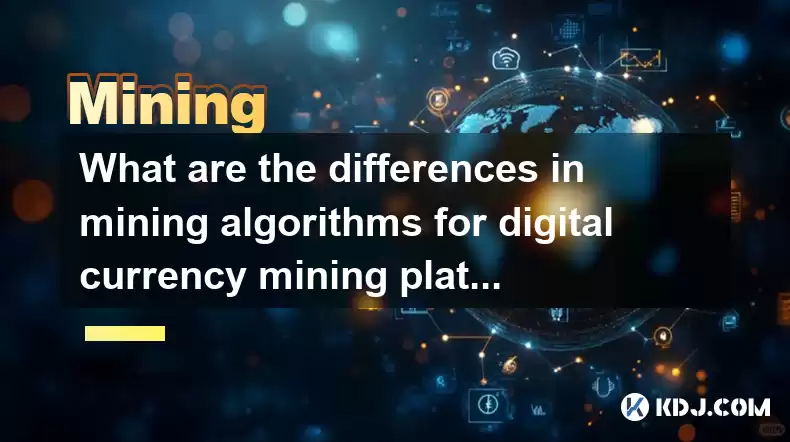
Understanding Cryptocurrency Mining Algorithms
Different cryptocurrencies employ different mining algorithms, impacting the hardware needed, the energy consumption, and the overall mining process. This article explores the variations among these algorithms and their implications for mining platforms. Choosing the right mining platform often hinges on understanding these differences and selecting one compatible with your chosen cryptocurrency.
Proof-of-Work (PoW) Algorithms: A Deep Dive
Many prominent cryptocurrencies, including Bitcoin, utilize Proof-of-Work (PoW) algorithms. These algorithms require miners to solve complex cryptographic puzzles to validate transactions and add new blocks to the blockchain. The first miner to solve the puzzle gets to add the block and receives a reward in cryptocurrency. The difficulty of these puzzles adjusts automatically to maintain a consistent block generation time. This dynamic difficulty adjustment is crucial for network stability.
Several PoW algorithms exist, each with its own characteristics. For example, SHA-256 (used by Bitcoin) is designed for ASIC miners, specialized hardware optimized for this specific algorithm. Scrypt (used by Litecoin), on the other hand, is more resistant to ASIC dominance, allowing for greater participation from GPU miners. This difference in ASIC resistance impacts the accessibility and cost of entry for miners.
Another notable PoW algorithm is Equihash (used by Zcash). Equihash is designed to be ASIC-resistant, promoting a more decentralized mining landscape. However, even ASIC-resistant algorithms can eventually see the development of specialized hardware, potentially shifting the balance of power within the mining community. The constant evolution of hardware and algorithms is a key feature of the cryptocurrency mining landscape.
Proof-of-Stake (PoS) Algorithms: An Alternative Approach
Proof-of-Stake (PoS) algorithms represent a significant departure from PoW. Instead of solving complex mathematical problems, PoS validators are selected based on the amount of cryptocurrency they stake. This process consumes far less energy than PoW, making it a more environmentally friendly alternative.
Different PoS algorithms employ varying methods for validator selection and block creation. Some algorithms utilize a random selection process weighted by stake size, while others incorporate more sophisticated mechanisms to prevent centralization. The specific algorithm used impacts the level of decentralization and security within the network. Examples of PoS algorithms include Ouroboros (used by Cardano) and Casper (used by Ethereum 2.0).
Delegated Proof-of-Stake (DPoS) Algorithms: A Hybrid Approach
Delegated Proof-of-Stake (DPoS) is a variation of PoS where token holders vote for delegates to validate transactions and create blocks. This approach aims to combine the security of PoS with improved efficiency and scalability. The elected delegates are responsible for securing the network and are rewarded for their services. However, DPoS systems can be susceptible to centralization if a small number of delegates control a significant portion of the network's voting power.
Algorithm Selection and Mining Platform Compatibility
The choice of mining algorithm directly influences the type of mining hardware required. ASIC miners are generally the most efficient for PoW algorithms like SHA-256, while GPUs are often preferred for ASIC-resistant algorithms or PoS validation. Mining platforms must be compatible with the chosen algorithm and hardware. Some platforms offer support for multiple algorithms, while others specialize in a specific one.
Selecting a mining platform also involves considering factors beyond the algorithm itself. Factors such as fees, payout methods, pool size, and security should all be carefully evaluated. A platform's reputation and user reviews can provide valuable insights into its reliability and performance. Understanding the nuances of different mining algorithms is crucial for making informed decisions about mining platform selection and maximizing mining profitability.
Algorithm Differences and Their Impact on Mining
The differences in mining algorithms have significant implications for the overall mining process. PoW algorithms generally require substantial computational power and energy consumption, leading to higher electricity costs. PoS and DPoS algorithms are significantly more energy-efficient. The choice of algorithm also influences the level of decentralization and the accessibility of mining for individuals.
ASIC-resistant algorithms tend to be more decentralized, as they prevent the dominance of specialized hardware. However, this can also lead to lower mining efficiency compared to ASIC-based mining. Understanding these trade-offs is crucial for choosing the right cryptocurrency and mining platform.
Choosing the Right Mining Platform: Key Considerations
When choosing a mining platform, consider the following:
- Supported Algorithms: Ensure the platform supports the algorithm of your chosen cryptocurrency.
- Hardware Compatibility: Verify that your mining hardware is compatible with the platform.
- Fees and Payouts: Compare fees and payout structures across different platforms.
- Pool Size and Stability: Larger pools generally offer greater stability and consistent payouts.
- Security and Reputation: Choose a reputable platform with a strong track record of security.
- Software and User Interface: Select a platform with user-friendly software and a clear interface.
Frequently Asked Questions
Q: What is the most profitable mining algorithm?
A: The profitability of a mining algorithm depends on several factors, including the cryptocurrency's price, the difficulty of the algorithm, and the cost of electricity. There is no single "most profitable" algorithm.
Q: Are all mining algorithms equally energy-efficient?
A: No, PoW algorithms are generally far less energy-efficient than PoS or DPoS algorithms. PoW algorithms require significantly more computational power and energy consumption.
Q: Can I mine any cryptocurrency on any mining platform?
A: No, mining platforms typically support specific algorithms. You need to choose a platform compatible with the algorithm of the cryptocurrency you wish to mine.
Q: What is the difference between ASIC and GPU mining?
A: ASIC miners are specialized hardware designed for specific algorithms, offering higher efficiency but less flexibility. GPUs are more versatile but generally less efficient for PoW algorithms optimized for ASICs.
Q: How does the difficulty of a mining algorithm affect profitability?
A: As the difficulty of a mining algorithm increases, the chances of successfully mining a block decrease, reducing profitability. The difficulty adjusts automatically to maintain a consistent block generation rate.
Disclaimer:info@kdj.com
The information provided is not trading advice. kdj.com does not assume any responsibility for any investments made based on the information provided in this article. Cryptocurrencies are highly volatile and it is highly recommended that you invest with caution after thorough research!
If you believe that the content used on this website infringes your copyright, please contact us immediately (info@kdj.com) and we will delete it promptly.
- XRP, DOGE, and the Altcoin Darling Dilemma: Where's the Alpha?
- 2025-08-06 08:30:11
- Beatrix Potter 50p Coins on eBay: A Collector's Guide to Value and Rarity
- 2025-08-06 08:50:12
- Dogecoin Price Outlook 2025: Barking Up the Right Tree?
- 2025-08-06 08:35:17
- Floki Price Super Cycle Watch: Key Support Holds, Will the Viking Dog Fly?
- 2025-08-06 08:50:12
- Executive Order vs. Financial Institutions: Is Political Bias the New Normal?
- 2025-08-06 08:55:11
- China, DeepSeek AI, and Crypto Prices: Decoding the Future of XRP, SHIB, and PEPE
- 2025-08-06 09:00:13
Related knowledge
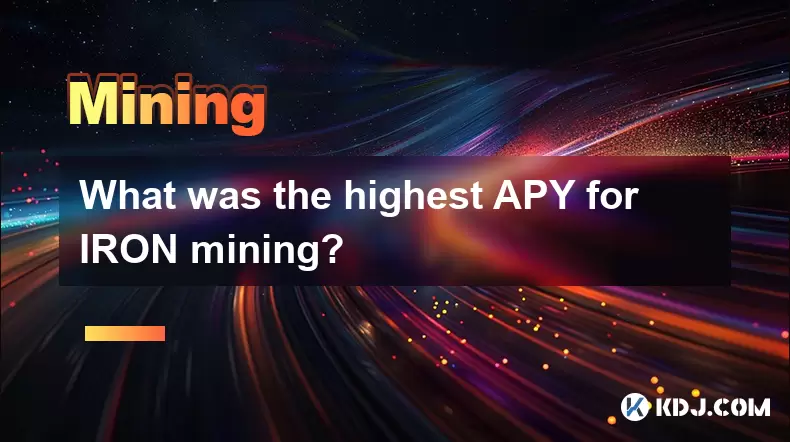
What was the highest APY for IRON mining?
Jul 23,2025 at 05:14am
Understanding IRON Token and Its Mining MechanismThe IRON token is a stablecoin that operates within the Iron Finance ecosystem, primarily on blockcha...

What is impermanent loss in IRON pools?
Jul 23,2025 at 09:00am
Understanding Impermanent Loss in the Context of IRON PoolsImpermanent loss is a phenomenon that affects liquidity providers in decentralized finance ...
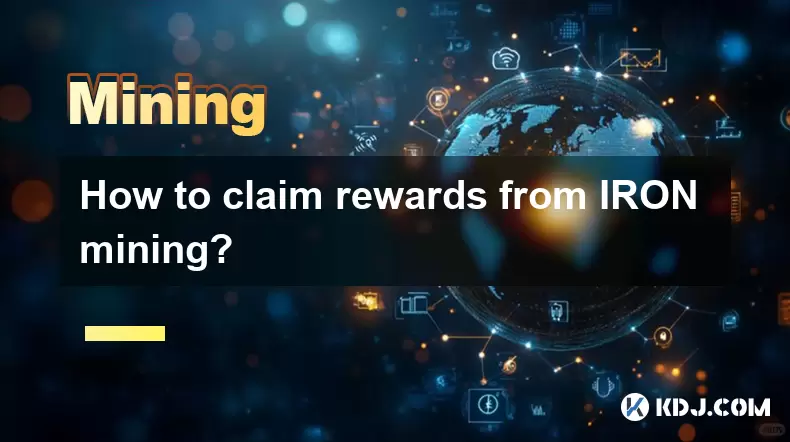
How to claim rewards from IRON mining?
Jul 23,2025 at 02:21pm
Understanding IRON Mining and Reward MechanismsIRON Finance operated as a decentralized finance (DeFi) protocol on the Polygon and Binance Smart Chain...
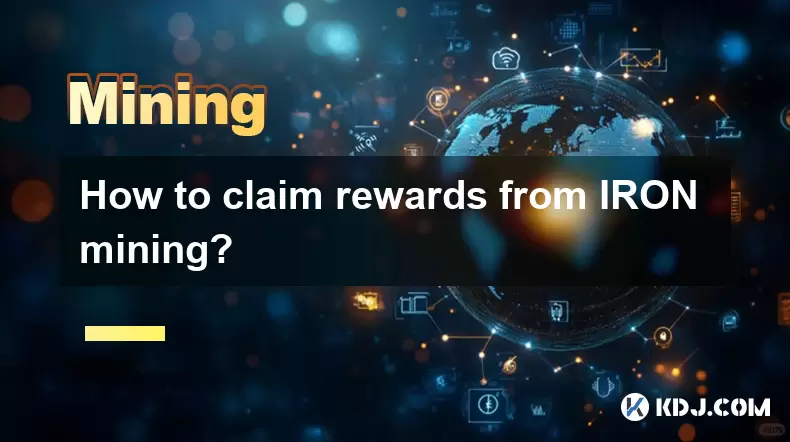
How to claim rewards from IRON mining?
Jul 29,2025 at 05:07am
Understanding IRON Mining and Reward MechanismIRON is a dual-token system designed to stabilize the value of a synthetic asset through a combination o...
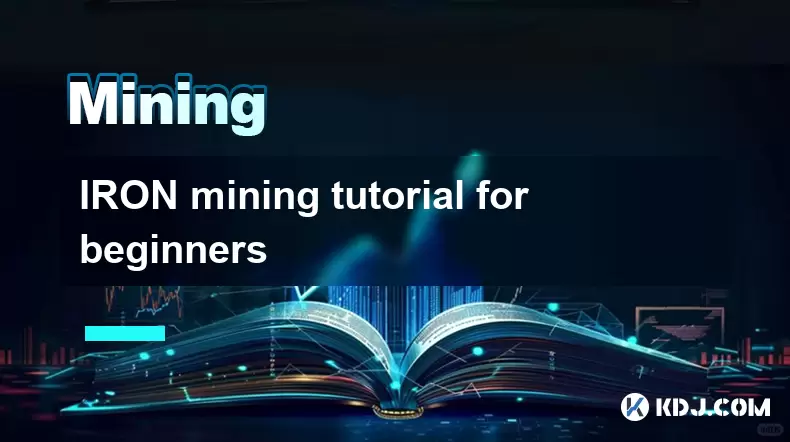
IRON mining tutorial for beginners
Jul 27,2025 at 12:01am
What Is IRON and How Does It Work in the Cryptocurrency Ecosystem?IRON is a cryptocurrency token that operates on the Binance Smart Chain (BSC) and is...
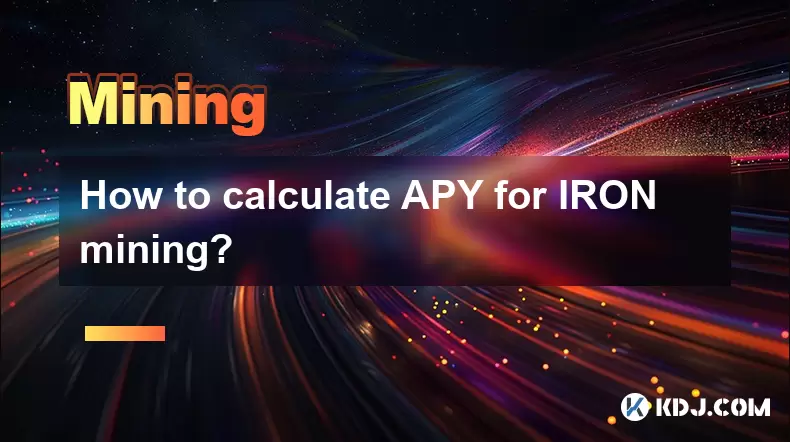
How to calculate APY for IRON mining?
Jul 28,2025 at 09:49am
Understanding APY in the Context of IRON Token MiningWhen engaging in IRON token mining within decentralized finance (DeFi) platforms, Annual Percenta...

What was the highest APY for IRON mining?
Jul 23,2025 at 05:14am
Understanding IRON Token and Its Mining MechanismThe IRON token is a stablecoin that operates within the Iron Finance ecosystem, primarily on blockcha...

What is impermanent loss in IRON pools?
Jul 23,2025 at 09:00am
Understanding Impermanent Loss in the Context of IRON PoolsImpermanent loss is a phenomenon that affects liquidity providers in decentralized finance ...

How to claim rewards from IRON mining?
Jul 23,2025 at 02:21pm
Understanding IRON Mining and Reward MechanismsIRON Finance operated as a decentralized finance (DeFi) protocol on the Polygon and Binance Smart Chain...

How to claim rewards from IRON mining?
Jul 29,2025 at 05:07am
Understanding IRON Mining and Reward MechanismIRON is a dual-token system designed to stabilize the value of a synthetic asset through a combination o...

IRON mining tutorial for beginners
Jul 27,2025 at 12:01am
What Is IRON and How Does It Work in the Cryptocurrency Ecosystem?IRON is a cryptocurrency token that operates on the Binance Smart Chain (BSC) and is...

How to calculate APY for IRON mining?
Jul 28,2025 at 09:49am
Understanding APY in the Context of IRON Token MiningWhen engaging in IRON token mining within decentralized finance (DeFi) platforms, Annual Percenta...
See all articles

























































































